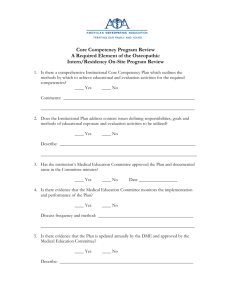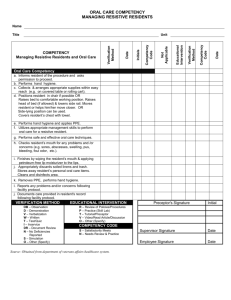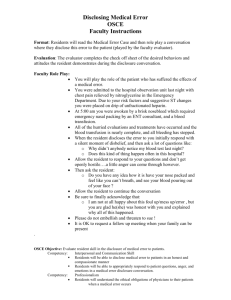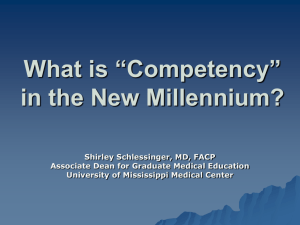Enter Student Name Enter School / Training Facility ARTICULATION
advertisement
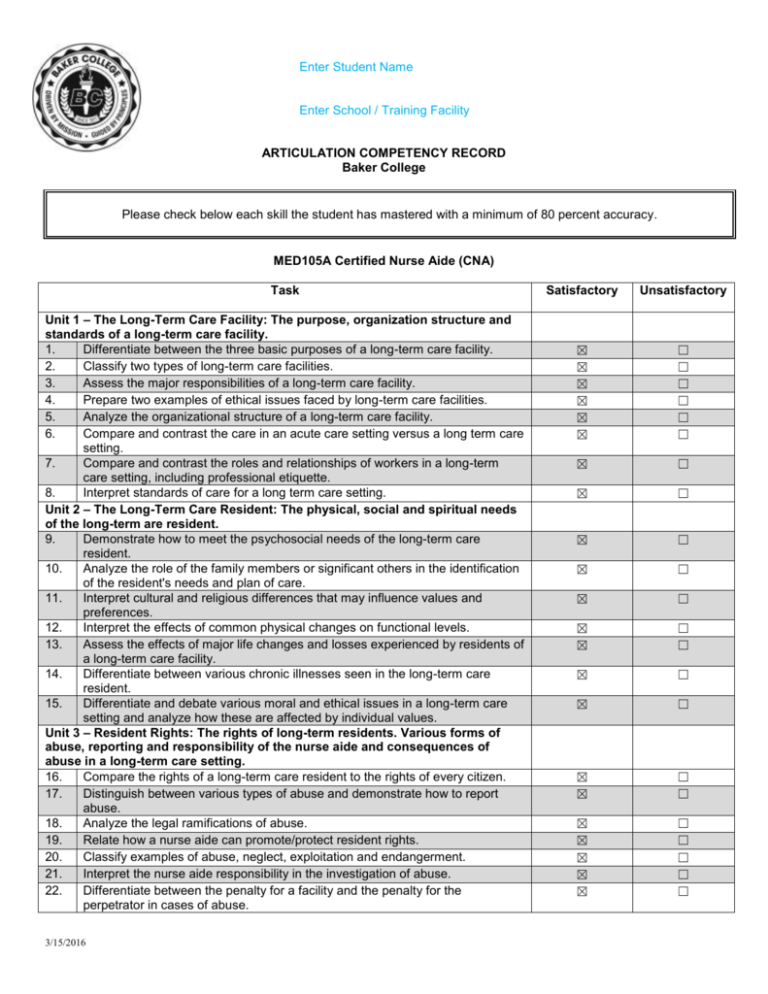
Enter Student Name Enter School / Training Facility ARTICULATION COMPETENCY RECORD Baker College Please check below each skill the student has mastered with a minimum of 80 percent accuracy. MED105A Certified Nurse Aide (CNA) Task Unit 1 – The Long-Term Care Facility: The purpose, organization structure and standards of a long-term care facility. 1. Differentiate between the three basic purposes of a long-term care facility. 2. Classify two types of long-term care facilities. 3. Assess the major responsibilities of a long-term care facility. 4. Prepare two examples of ethical issues faced by long-term care facilities. 5. Analyze the organizational structure of a long-term care facility. 6. Compare and contrast the care in an acute care setting versus a long term care setting. 7. Compare and contrast the roles and relationships of workers in a long-term care setting, including professional etiquette. 8. Interpret standards of care for a long term care setting. Unit 2 – The Long-Term Care Resident: The physical, social and spiritual needs of the long-term are resident. 9. Demonstrate how to meet the psychosocial needs of the long-term care resident. 10. Analyze the role of the family members or significant others in the identification of the resident's needs and plan of care. 11. Interpret cultural and religious differences that may influence values and preferences. 12. Interpret the effects of common physical changes on functional levels. 13. Assess the effects of major life changes and losses experienced by residents of a long-term care facility. 14. Differentiate between various chronic illnesses seen in the long-term care resident. 15. Differentiate and debate various moral and ethical issues in a long-term care setting and analyze how these are affected by individual values. Unit 3 – Resident Rights: The rights of long-term residents. Various forms of abuse, reporting and responsibility of the nurse aide and consequences of abuse in a long-term care setting. 16. Compare the rights of a long-term care resident to the rights of every citizen. 17. Distinguish between various types of abuse and demonstrate how to report abuse. 18. Analyze the legal ramifications of abuse. 19. Relate how a nurse aide can promote/protect resident rights. 20. Classify examples of abuse, neglect, exploitation and endangerment. 21. Interpret the nurse aide responsibility in the investigation of abuse. 22. Differentiate between the penalty for a facility and the penalty for the perpetrator in cases of abuse. 3/15/2016 Satisfactory Unsatisfactory ☒ ☒ ☒ ☒ ☒ ☒ ☐ ☐ ☐ ☐ ☐ ☐ ☒ ☐ ☒ ☐ ☒ ☐ ☒ ☐ ☒ ☐ ☒ ☒ ☐ ☐ ☒ ☐ ☒ ☐ ☒ ☒ ☐ ☐ ☒ ☒ ☒ ☒ ☒ ☐ ☐ ☐ ☐ ☐ Unit 4 – The Nurse Aide as a Member of the Health Care Team: 23. Differentiate between the various roles and responsibilities of a nurse aide in a long-term care facility. 24. Compare ethical versus unethical behaviors in a long-term care facility. 25. Interpret scope of practice for nurse aides. 26. Distinguish between the scope of practice of a nurse aide versus a licensed practical nurse and registered nurse in developing the plan of care for a longterm care resident. 27. Assess the qualities of an effective nurse aide. 28. Interpret the meaning of taking care of oneself in order to care for others. Unit 5 – Human Interaction: The dynamics of human interaction between staff, staff and residents and staff and family members in the long-term care setting: 29. Assess elements necessary for effective communication. 30. Demonstrate four methods to facilitate communication with residents in a longterm care facility. 31. Interpret the dynamics for human interaction between staff members, the resident and their families. 32. Construct strategies to address the communication needs of residents with special needs. 33. Analyze how to resolve conflicts between residents, staff and family members. Unit 6 – Infection Control: The importance of hand washing and universal precautions in the prevention of the spread of infection. 34. Assess the various methods used to control the spread of infection in the longterm care setting. 35. Demonstrate, at 100% competency without cueing, proper hand washing. 36. Demonstrate, at 100% competency without cueing, isolation precautions and techniques. 37. Demonstrate, at 100% competency without cueing, universal precaution techniques. 38. Differentiate between various infectious processes such as hepatitis, tuberculosis and influenza. 39. Distinguish between various methods of the spread of infection in the long-term care setting. 40. Classify the most common organisms found in a long-term care setting. 41. Select various requirements needed for the growth of microorganisms. 42. Analyze how the aging process makes a person more susceptible to infections. 43. Select various signs and symptoms of infections. 44. Demonstrate how to report and record observations of the resident with an infection. Unit 7 – Safety and Emergency Procedures: 45. Interpret various emergency situations in a long-term care setting. 46. Demonstrate, at 100% competency without cueing, the care of a resident who is bleeding. 47. Demonstrate, at 100% competency without cueing, the care of the resident who is having a seizure. 48. Demonstrate, at 100% competency without cueing, the care of the resident with burns. 49. Demonstrate, at 100% competency without cueing, the Heimlich maneuver. 50. Demonstrate, at 100% competency without cueing, the care of an unconscious resident. 51. Assess common causes of falls, burns and bleeding in a long-term care setting. 52. Evaluate ways to prevent falls, burns and bleeding in the long-term care setting. 53. Demonstrate, at 100% competency without cueing, how to assist the resident who is falling/falls. 54. Analyze common causes of respiratory emergencies in the long-term care environment. 3/15/2016 ☒ ☐ ☒ ☒ ☒ ☐ ☐ ☐ ☒ ☒ ☐ ☐ ☒ ☒ ☐ ☐ ☒ ☐ ☒ ☐ ☒ ☐ ☒ ☐ ☒ ☒ ☐ ☐ ☒ ☐ ☒ ☐ ☒ ☐ ☒ ☒ ☒ ☒ ☒ ☐ ☐ ☐ ☐ ☐ ☒ ☒ ☐ ☐ ☒ ☐ ☒ ☐ ☒ ☒ ☐ ☐ ☒ ☒ ☐ ☐ ☒ ☐ ☒ ☐ 55. Differentiate between respiratory and cardiac arrest, discuss nurse aide responses to these emergencies. 56. Analyze common reasons why a resident may lose consciousness. 57. Assess various fire prevention guidelines, fire hazards and how to respond to a fire in the long-term care setting. 58. Demonstrate, at 100% competency without cueing, the steps to take in the event of a fire in a long-term care setting. 59. Demonstrate, at 100% competency the ability to provide all safety measures related to indirect care guidelines. 60. Verify the responsibilities of the nurse aide in the event of severe weather in a long-term care setting. Unit 8 – The Basic Personal Care Needs of the Long-Term Care Resident: 61. Plan measures that promote the comfort, dignity, safety, cleanliness and independence of residents in a long-term care setting. 62. Interpret the relationship between personal care and resident rights in the longterm care setting. 63. Use the nine basic steps prior to and following all personal care contact with the resident. 64. Relate the importance of oral hygiene. 65. List the various levels of assistance for oral hygiene. 66. Explain the safety precautions for performing oral hygiene. 67. List the components/equipment/sequencing needed to perform oral care for the resident with natural teeth. 68. List the components/equipment/sequencing used for the performance or oral hygiene for the resident with dentures. 69. List the components/equipment/sequencing used to perform oral hygiene for the resident without teeth or dentures. 70. List the components/equipment/sequencing used to perform oral hygiene for the resident with special needs. 71. Assess the skin changes that occur with aging. 72. Interpret the importance of skin care. 73. List methods to maintain healthy skin. 74. List the components/equipment/sequencing needed to perform skin care. 75. Demonstrate, at 100% competency without cueing, techniques utilized by a Certified Nurse Aide to help prevent skin breakdown. 76. List the observations/components/equipment/sequencing needed to perform perineal care. 77. List the observations/risk factors/components/equipment/sequencing needed to perform foot care. 78. List the observations/components/equipment/sequencing needed to perform nail care. 79. List the observations/components/equipment/sequencing needed to perform dressing and undressing. 80. List the observations/components/equipment/sequencing needed to perform grooming and shaving. 81. List the observations/components/equipment/sequencing needed to perform bathing (bed, tub)/showering. 82. Demonstrate, at 100% competency without cueing, oral hygiene. 83. Demonstrate, at 100% competency without cueing, skin care. 84. Demonstrate, at 100% competency without cueing, perineal care (male and female). 85. Demonstrate, at 100% competency without cueing, nail care. 86. Demonstrate, at 100% competency without cueing, foot care. 87. Demonstrate, at 100% competency without cueing, dressing and undressing. 88. Demonstrate, at 100% competency without cueing, grooming and shaving. 89. Demonstrate, at 100% competency without cueing, bathing (tub/bed/showering). 3/15/2016 ☒ ☐ ☒ ☒ ☐ ☐ ☒ ☐ ☒ ☐ ☒ ☐ ☒ ☐ ☒ ☐ ☒ ☐ ☒ ☒ ☒ ☒ ☐ ☐ ☐ ☐ ☒ ☐ ☒ ☐ ☒ ☐ ☒ ☒ ☒ ☒ ☒ ☐ ☐ ☐ ☐ ☐ ☒ ☐ ☒ ☐ ☒ ☐ ☒ ☐ ☒ ☐ ☒ ☐ ☒ ☒ ☒ ☐ ☐ ☐ ☒ ☒ ☒ ☒ ☒ ☐ ☐ ☐ ☐ ☐ 90. 91. List observations that should be made during personal care. Demonstrate, at 100% competency without cueing, bathing (tub/bed/showering). 92. Evaluate the role of the nurse aide in reporting and observing during the provision of personal care. Unit 9 – Care of the Resident Environment 93. Interpret what constitutes the resident environment and the nurse aide’s role in maintaining and reporting on the conditions of the resident's environment. 94. Analyze the psychosocial importance of the resident environment and appropriate methods to maintain a safe environment. 95. Identify unsafe conditions in the resident environment and predict what may result from unsafe conditions. 96. Compare and contrast methods of bed-making and how they impact on the skin condition of the resident. 97. Verify proper bed operation. 98. Verify proper infection control measures during bed-making. 99. Verify situations that warrant linen changes. 100. Verify the use of proper specialized equipment during bed-making. 101. Demonstrate, at 100% competency without cueing, unoccupied bed-making. 102. Demonstrate, at 100% competency without cueing, occupied bed-making. 103. Assess and correct any safety issues as related to the resident environment. 104. Demonstrate, at 100% competency without cueing, methods to maintain a safe environment. 105. Demonstrate, at 100% competency without cueing, appropriate documentation as it relates to the resident environment. 106. Assess and correct any safety issues as related to the resident environment. Unit 10 – Care of the Resident with Cognitive Impairment 107. Classify and compare various types, causes, and effects of cognitive impairment. 108. Evaluate different methods of handling situations involving the cognitively impaired resident. 109. Evaluate the implications for care of the cognitively impaired resident. 110. Demonstrate, at 100% competency without cueing, in the clinical setting the appropriate responses to a resident with cognitive impairment. 111. Identify methods used to minimize confusion and prevent altered behavior in the resident with cognitive impairment. 112. Identify ways to prevent and eliminate the use of physical and chemical restraints for residents with cognitive impairment. 113. Identify methods to promote resident rights for the person with cognitive impairment. 114. Debate various attitudes and feelings a nurse aide may experience in caring for a resident with cognitive impairment. 115. Assess various ways to use the resident's family/significant other as a source of information and support. 116. Select methods to promote resident rights for the person with cognitive impairment. Unit 11 – Creating an Environment for Restraint Elimination, Reduction and Appropriate Use 117. Differentiate between physical and chemical restraints. 118. Classify various types of physical restraints from greatest too least restrictive. 119. Compare and contrast various strategies used to reduce the use of physical and chemical restraints. 120. Distinguish the appropriate and inappropriate use of restraints. 121. Demonstrate, at 100% competency without cueing, appropriate observations to make while a resident is physically restrained. 3/15/2016 ☒ ☒ ☐ ☐ ☒ ☐ ☒ ☐ ☒ ☐ ☒ ☐ ☒ ☐ ☒ ☒ ☒ ☒ ☒ ☒ ☒ ☒ ☐ ☐ ☐ ☐ ☐ ☐ ☐ ☐ ☒ ☐ ☒ ☐ ☒ ☐ ☒ ☐ ☒ ☒ ☐ ☐ ☒ ☐ ☒ ☐ ☒ ☐ ☒ ☐ ☒ ☐ ☒ ☐ ☒ ☒ ☒ ☐ ☐ ☐ ☒ ☒ ☐ ☐ 122. Demonstrate, at 100% competency without cueing, the application of various other restraints and determine if they provide maximum restraint or minimal restraint. 123. Verify appropriate observations to make for a resident who is chemically and/or physically restrained. 124. Demonstrate at 100% competency observation of patient behaviors that require immediate reporting to the nurse. Unit 12 – Vital Signs and Measurement of Height and Weight 125. Demonstrate, at 100% competency without cueing, how to take and record an oral temperature using an electronic thermometer. 126. Demonstrate, at 100% competency without cueing, how to take and record a rectal temperature using an electronic thermometer. 127. Demonstrate, at 100% competency without cueing, how to take and record an axillary temperature using an electronic thermometer. 128. Identify the normal range for an oral, rectal and axillary temperature. 129. Identify factors that affect body temperature. 130. Identify various sites used to take a pulse. 131. Identify the normal range for an adult pulse. 132. Verify factors/conditions that affect pulse rate. 133. Demonstrate, at 100% competency without cueing, how to take and record a radial pulse. 134. Identify the normal range for adult respiration. 135. Verify factors and conditions that affect respiratory rate. 136. Demonstrate, at 100% competency without cueing, how to take and record respiration. 137. Identify the normal range for adult blood pressure. 138. Verify conditions/factors that can affect blood pressure. 139. Demonstrate, at 100% competency without cueing, how to take and record blood pressure. 140. Illustrate the basic anatomy and physiology of the heart. 141. Evaluate the importance of accuracy in performing and recording temperature, pulse, respiration and blood pressure. 142. Interpret trends in vital sign measurement. 143. Relate the importance of measuring height and weight to the overall health status of the resident. 144. Identify factors that affect the residents' height and weight. 145. Demonstrate, at 100% competency without cueing, how to take and record height on a stand up scale. 146. Relate the importance of measuring height and weight to the overall health status of the resident. Unit 13 – Meeting Nutrition/Hydration Needs of the Nursing Home Resident 147. Assess the nutrition/hydration needs of a resident in a long-term care facility. 148. Identify the physical changes of aging that affect the nutrition/hydration status of residents in a long-term care facility and the changes that may occur as a result of inadequate hydration and nutrition. 149. Analyze psychosocial factors that affect the nutrition/hydration status of the long-term care resident. 150. Identify various types of special diets that may be prescribed in a long-term care facility. 151. Evaluate various strategies that may be utilized to maintain/improve the residents' nutrition/hydration status. 152. Identify alternative therapies for providing nutrition/hydration to the long-term care resident. 153. Compare and contrast the various roles of the health care team in the maintenance of nutrition/hydration in the long-term care facility. 154. Calculate intake and output. 3/15/2016 ☒ ☐ ☒ ☐ ☒ ☐ ☒ ☐ ☒ ☐ ☒ ☐ ☒ ☒ ☒ ☒ ☒ ☒ ☐ ☐ ☐ ☐ ☐ ☐ ☒ ☒ ☒ ☐ ☐ ☐ ☒ ☒ ☒ ☐ ☐ ☐ ☒ ☒ ☐ ☐ ☒ ☒ ☐ ☐ ☒ ☒ ☐ ☐ ☒ ☐ ☒ ☒ ☐ ☐ ☒ ☐ ☒ ☐ ☒ ☐ ☒ ☐ ☒ ☐ ☒ ☐ 155. Identify various reasons why a resident would need intake and output measurement. 156. Evaluate the nurse aide role in reporting and documenting intake and output. 157. Demonstrate, at 100% competency without cueing, feeding a resident requiring partial assistance and complete assistance and completion of the intake and output form. Unit 14 - Elimination 158. Demonstrate an understanding of the anatomy of different routes of elimination. 159. Identify aging changes that affect bowel and bladder elimination. 160. Assess common elimination problems that may occur in the long-term care setting. 161. Demonstrate at 100% competency observation of abnormal findings related to elimination that require immediate reporting to the nurse. 162. Interpret the impact of restraint use on elimination patterns. 163. Identify various methods to enhance elimination. 164. Evaluate the nurse aide's role in bowel and bladder training. 165. Identify various methods to prevent common elimination problems. 166. Demonstrate an understanding of the term "incontinence". 167. Assess factors that may cause incontinence. 168. Evaluate the impact of incontinence on the long-term care resident. 169. Verify methods of decreasing and preventing incontinence. 170. Demonstrate, at 100% competency without cueing, the appropriate techniques for toileting a resident in a bathroom. 171. Demonstrate, at 100% competency without cueing, the appropriate technique for giving a bedpan to a resident. 172. Demonstrate, at 100% competency without cueing, the appropriate technique for giving a urinal to a resident. 173. Demonstrate, at 100% competency without cueing, the appropriate technique for using a bedside commode. 174. Classify various urinary catheters. 175. Verify reasons why urinary catheters are used. 176. Demonstrate, at 100% competency without cueing, the proper care techniques for a resident with a urinary catheter. 177. Demonstrate, at 100% competency without cueing, the collection of a urine sample. 178. Demonstrate, at 100% competency without cueing, the collection of a stool sample. Unit 15 – Rehabilitative and Restorative Care 179. Demonstrate, at 100% competency without cueing, the proper care techniques for a resident with a urinary catheter. 180. Compare and contrast the differences between restorative and rehabilitative care and select and interpret the roles of various members of the rehab/restorative team. 181. Assess the role of the nurse aide as an integral part of the rehab/restorative team. 182. Distinguish between proper and improper body mechanics for the nurse aide and resident. 183. Demonstrate, at 100% competency without cueing, proper body mechanics for the nurse aide. 184. Demonstrate, at 100% competency without cueing, proper body mechanics for the resident. 185. Demonstrate, at 100% competency without cueing, proper ambulation techniques using a walker. 186. Demonstrate, at 100% competency without cueing, proper ambulation techniques using a cane. 187. Demonstrate, at 100% competency without cueing, proper ambulation techniques using one or two person assist. 3/15/2016 ☒ ☐ ☒ ☒ ☐ ☐ ☒ ☒ ☒ ☐ ☐ ☐ ☒ ☐ ☒ ☒ ☒ ☒ ☒ ☒ ☒ ☒ ☒ ☐ ☐ ☐ ☐ ☐ ☐ ☐ ☐ ☐ ☒ ☐ ☒ ☐ ☒ ☐ ☒ ☒ ☒ ☐ ☐ ☐ ☒ ☐ ☒ ☐ ☒ ☐ ☒ ☐ ☒ ☐ ☒ ☐ ☒ ☐ ☒ ☐ ☒ ☐ ☒ ☐ ☒ ☐ 188. Demonstrate, at 100% competency without cueing, proper ambulation techniques with standby assist. 189. Demonstrate, at 100% competency without cueing, proper use of a wheelchair. 190. Demonstrate, at 100% competency without cueing, proper one-person transfer technique from a bed to a wheelchair. 191. Demonstrate, at 100% competency without cueing, a one-person transfer from a wheelchair to a bed. 192. Demonstrate, at 100% competency without cueing, a one-person transfer from a wheelchair to a toilet. 193. Demonstrate, at 100% competency without cueing, a two-person transfer of a person from a bed to a commode. 194. Evaluate the benefits of proper positioning and turning. 195. Determine factors that impact the frequency of positioning/turning a resident. 196. Evaluate the nurse aide responsibility in reporting and recording positioning/turning of the resident. 197. Demonstrate, at 100% competency without cueing, proper use of equipment for positioning and turning the resident. 198. Evaluate the importance of range of motion exercises for the long-term care resident. 199. Demonstrate, at 100% competency without cueing, passive range of motion. 200. Demonstrate, at 100% competency without cueing, active range of motion. 201. Demonstrate, at 100% competency the purpose and proper use of a mechanical lift. Unit 16 – Care of the Resident with Mental Retardation 202. Assess various characteristics of the resident with mental retardation. 203. Identify common causes of mental retardation. 204. Evaluate the nurse aide role in caring for the resident with mental retardation. Unit 17 – Depression 205. Identify and understand when to notify the nurse of symptoms of depression in the elderly resident. 206. Demonstrate effective communication with a resident diagnosed with depression. 207. Evaluate the nurse aide's role in caring for the resident who is depressed. Unit 18 – Death and Dying 208. Compare and contrast various feeling and responses a resident or family member may have during the dying process. 209. Evaluate the nurse aide role in caring for the dying resident. 210. Evaluate the nurse aide role in caring for the family of a dying resident. 211. Assess the active process of dying. 212. Appraise the nurse aide's own feelings about death and dying and how they may impact their ability to care for the dying resident. 213. Identify and understand methods to cope with death and dying in a long-term care facility. 214. Demonstrate, at 100% competency without cueing, post-mortem care. Unit 19 – The Resident with Acquired Immune Deficiency Syndrome 215. Define and identify the causative agent of AIDS. 216. Analyze one's own feelings and attitudes about caring for the resident with AIDS. 217. Evaluate the nurse aide role in caring for the resident with AIDS. Teacher signature 3/15/2016 Enter Date ☒ ☐ ☒ ☒ ☐ ☐ ☒ ☐ ☒ ☐ ☒ ☐ ☒ ☒ ☒ ☐ ☐ ☐ ☒ ☐ ☒ ☐ ☒ ☒ ☒ ☐ ☐ ☐ ☒ ☒ ☒ ☐ ☐ ☐ ☒ ☐ ☒ ☐ ☒ ☐ ☒ ☐ ☒ ☒ ☒ ☒ ☐ ☐ ☐ ☐ ☒ ☐ ☒ ☐ ☒ ☒ ☐ ☐ ☒ ☐
